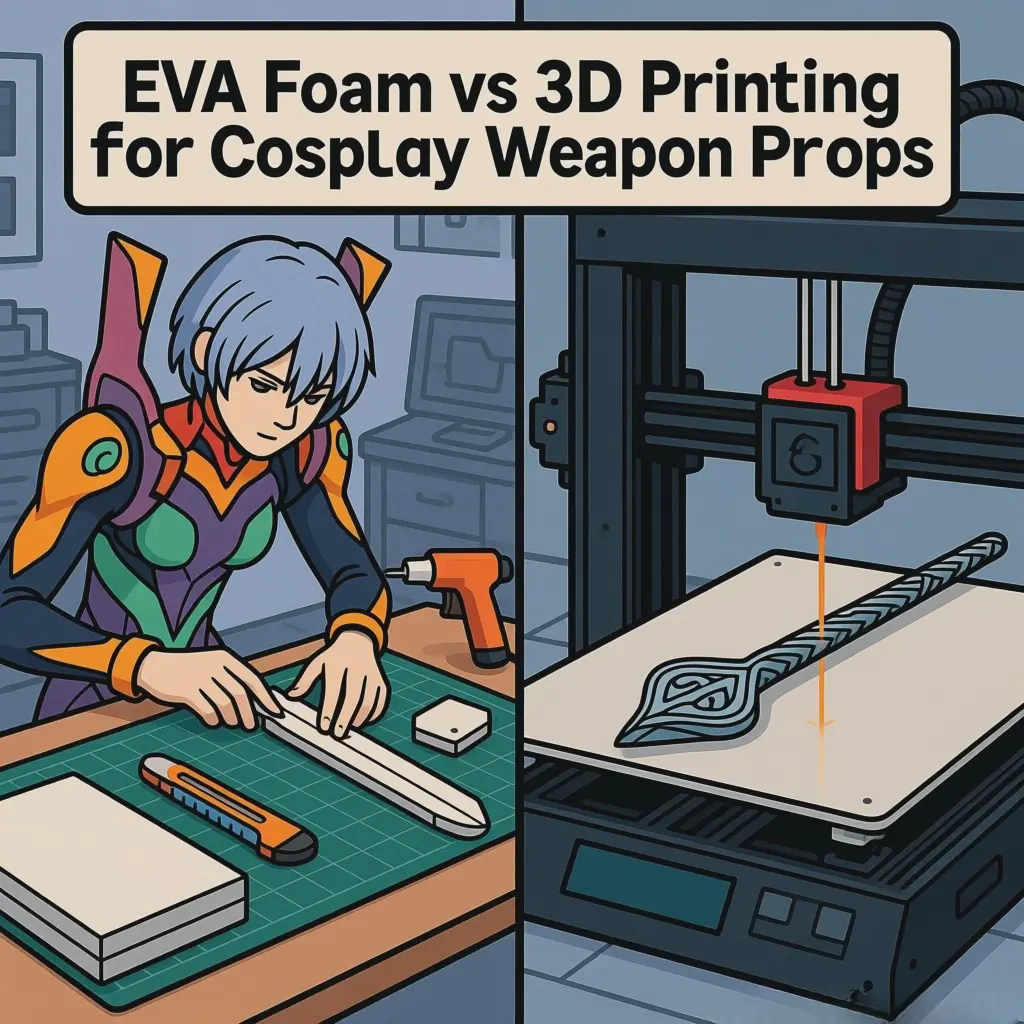What is the Better Method for Cosplay Weapon Props: EVA Foam or 3D Printing?
1. Introduction
Cosplay weapon props play a crucial role in bringing a character to life. When it comes to creating these props, two popular methods are using EVA foam and 3D printing. Each method has its own set of advantages and disadvantages, and the choice depends on various factors such as the design complexity, durability requirements, budget, and time constraints of the cosplay project.
2. EVA Foam: An In-Depth Look
2.1 Material Characteristics
- EVA foam, or ethylene-vinyl acetate foam, is a lightweight, flexible, and relatively soft material. It comes in different thicknesses, which makes it versatile for various cosplay weapon designs. For example, thinner sheets can be used for detailing, while thicker ones can form the main body of a prop. Its softness allows for easy shaping and molding, even for those with limited crafting skills.
2.2 Advantages
- Cost-Effective: EVA foam is generally inexpensive, especially when purchased in bulk. This makes it an attractive option for cosplayers on a tight budget. For instance, a large roll of EVA foam can cost significantly less than the materials and equipment required for 3D printing, allowing cosplayers to create multiple props without breaking the bank.
- Easy to Work With: It can be cut, shaped, and glued using common household tools. A simple craft knife can be used to cut the foam into the desired shape, and hot glue or contact cement can be used to assemble the pieces. This accessibility means that beginners can quickly start creating cosplay weapon props with EVA foam.
- Lightweight: Since cosplayers often need to carry their weapon props around for extended periods, the lightweight nature of EVA foam is a major plus. It reduces fatigue during conventions or events, making it more comfortable to wear and pose with the prop.
2.3 Disadvantages
- Limited Durability: EVA foam is not as durable as some other materials. It can tear, scratch, or deform relatively easily, especially if the prop is handled roughly. For example, a sword-shaped prop made of EVA foam may get dented if accidentally bumped against a hard surface.
- Lack of Fine Detail: While it's possible to add some detail to EVA foam props, achieving highly intricate and precise details can be challenging. The softness of the foam may cause fine details to be lost during the shaping and finishing process.
3. 3D Printing: An In-Depth Look
3.1 Material Characteristics
- 3D printing uses a variety of materials, such as PLA (polylactic acid), ABS (acrylonitrile butadiene styrene), and resin. These materials offer different levels of strength, flexibility, and surface finish. PLA is biodegradable and has a relatively smooth surface finish, while ABS is more durable and impact-resistant.
3.2 Advantages
- High-Precision Detailing: 3D printing can create highly detailed and complex designs with great accuracy. Cosplayers can bring to life the most intricate patterns, engravings, and textures on their weapon props. For example, a 3D-printed magic staff could have detailed runes or a highly detailed dragon-shaped handle that would be extremely difficult to replicate with EVA foam.
- Durability: 3D - printed props made from materials like ABS or resin are generally more durable than EVA foam props. They can withstand more handling, impact, and wear - and - tear. This makes them suitable for cosplays where the weapon prop needs to be more robust, such as in action-packed convention skits.
3.3 Disadvantages
- High Cost: The initial investment in a 3D printer can be substantial, and the cost of printing materials can also add up, especially for larger or more complex props. Additionally, if you don't own a 3D printer, you may need to pay for 3D printing services, which can be expensive depending on the size and complexity of the prop.
- Technical Skills Required: Operating a 3D printer requires some technical knowledge. You need to be able to design or obtain 3D models, slice the models for printing, and adjust various printing settings to ensure a successful print. This can be a steep learning curve for beginners.
4. Choosing the Right Method
4.1 Design Complexity
- If the cosplay weapon prop has a simple design with few details, EVA foam may be sufficient. However, for highly detailed and complex designs, 3D printing is the better option. For example, a basic wooden - looking club could be easily made with EVA foam, but a highly detailed, otherworldly dagger with elaborate carvings would be better suited for 3D printing.
4.2 Durability Requirements
- If the prop needs to be highly durable, such as for a cosplay where the character is constantly in combat or for long-term display, 3D printing is the way to go. But if the prop is mainly for show and will be handled gently, EVA foam can work well.
4.3 Budget
- For cosplayers on a tight budget, EVA foam is the more cost-effective choice. However, if budget is not a major constraint and you're willing to invest in the equipment or services, 3D printing can offer high-quality results.
4.4 Time Constraints
- EVA foam allows for relatively quick creation, especially for those experienced with working with it. 3D printing, on the other hand, can be time-consuming, from the design or model-obtaining stage to the actual printing process, which may take several hours or even days depending on the size and complexity of the prop.
5. FAQ
Q: Can I combine EVA foam and 3D printing for a cosplay weapon prop?
A: Absolutely! You can use 3D printing to create the highly detailed parts of the prop, such as the hilt of a sword, and then use EVA foam for the more straightforward and cost-effective parts like the blade. This way, you can leverage the advantages of both methods.
Q: Are there any safety concerns with EVA foam or 3D-printed props?
A: With EVA foam, when using adhesives, make sure to work in a well-ventilated area as some glues can emit fumes. For 3D printing, if using certain materials like resin, there may be health risks associated with exposure to uncured resin, so proper safety equipment like gloves and a respirator should be used. Also, 3D-printed props may be heavier than EVA foam props, so consider the comfort and safety of wearing or handling them for extended periods.
6. Conclusion
Both EVA foam and 3D printing have their own merits and demerits for creating cosplay weapon props. By carefully considering the design complexity, durability needs, budget, and time constraints of your cosplay project, you can make an informed decision on which method is better suited to bring your cosplay weapon prop to life.





